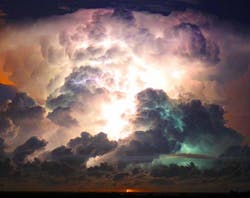Devastating correlations: NOAA Climate report shows all-time highs in Temps, C02, Glacier melt, Methane
(This is an opinion piece by the editor, but includes substantiated data from scientific research).
The energy chaos enveloping Europe in the wake of heat waves and the Russian invasion of Ukraine have many critics questioning whether the continent was irresponsible in making the shift away from fossil fuels too fast.
Same thing in Texas, where the quantum growth in wind energy sometimes does not fill in the gap at times of peak demand. More baseload, more flexible generation, energy transition critics say.
Valid challenges, but recent data from the U.S. National Oceanic and Atmospheric Administration shows that a much longer-term crisis is happening in the atmosphere, and greenhouse gas emissions are implicated in very tangible ways.
NOAA’s State of the Climate report indicates that even a persistent La Niña weather phenomenon, which historically depresses temperatures and cools down patterns, could not stop the relentless rise in heat-related climate events in the U.S. and around the world. The year 2021 was slightly cooler than recent years, thanks to La Niña somewhat, but still one of the seven warmest years on record since data was first accumulated in the 1880s. Read the full NOAA State of the Climate 2021 report by clicking here.
In fact, every year since 2015 comprises the seven hottest years on record. And those seven years of bad, hot luck coincide directly with the ever increasing amounts of greenhouse gases such as carbon dioxide and methane being released into the atmosphere, according to NOAA.
The annual global average carbon dioxide (CO2) concentration was measured at 414.7 parts per million, plus or minus 0.1 ppm, in 2021, the report reads. This is in increase of 2.6 ppm just in the past two years, showing that the emissions reduction achieved by COVID-19 shutdowns was short-lived. It is compared to less 350 ppm recorded in 1980, according to federal stats.
By contrast, the U.S. EPA standard on sulfur concentation in diesel fuel is 15 parts per million or less.
NOAA joins EPRI in studying Climate Risks in the Energy Sector
FuelCell Energy survey reveals skepticism around C&I Climate Pledges
U.S. Industriy Giants join DOE Better Climate Challenge
NOAA’s data also shows that the growth rate for methane was the highest on record, while nitrous oxide levels also rose to record high atmospheric concentration levels.
One can argue that these are two different things that just happened to occur side by side, but that seems to be an awfully incredible coincidence. Global glacier mass receded for the 34th straight year, and the worldwide mean sea level rose to record high for the tenth straight year, topping 97 millimeters above the 1993 average.
Heat waves stressed residents and power grids around the world, including all-time measured highs in the normally placid Pacific Northwest. The always hot Furnace Creek in Death Valley, California, found a way to get even hotter, reaching 54.4 C (130 degrees Fahrenheit) and now sharing the hottest earthly temp measured since 1931.
Something is happening, Mr. Jones, and we can act like we don’t know what it is...but we do. A wise man once said the energy transition is not a race to renewables but to decarbonization, so the answer can also lay in more efficient buildings, lower emitting conventional power, green hydrogen development, carbon capture and nuclear, as well as solar, wind and energy storage.
Maybe the rush to appease ESG expectations has caused significant problems throughout Europe due to the catastrophe of war in Ukraine, but a clear and consistent line of data from our skies and oceans and air patterns is proving the point that something must be done and done as soon as possible.
The numbers are not on our side. And this also is a war against time.
-- -- --
(Rod Walton, senior editor for EnergyTech, is a 14-year veteran of covering the energy industry both as a newspaper and trade journalist. He can be reached at [email protected]).
Follow us on Twitter @EnergyTechNews_ and @rodwaltonelp and look us up on LinkedIn
About the Author
Rod Walton, EnergyTech Managing Editor
Managing Editor
For EnergyTech editorial inquiries, please contact Managing Editor Rod Walton at [email protected].
Rod Walton has spent 17 years covering the energy industry as a newspaper and trade journalist. He formerly was energy writer and business editor at the Tulsa World. Later, he spent six years covering the electricity power sector for Pennwell and Clarion Events. He joined Endeavor and EnergyTech in November 2021.
Walton earned his Bachelors degree in journalism from the University of Oklahoma. His career stops include the Moore American, Bartlesville Examiner-Enterprise, Wagoner Tribune and Tulsa World.
EnergyTech is focused on the mission critical and large-scale energy users and their sustainability and resiliency goals. These include the commercial and industrial sectors, as well as the military, universities, data centers and microgrids. The C&I sectors together account for close to 30 percent of greenhouse gas emissions in the U.S.
He was named Managing Editor for Microgrid Knowledge and EnergyTech starting July 1, 2023
Many large-scale energy users such as Fortune 500 companies, and mission-critical users such as military bases, universities, healthcare facilities, public safety and data centers, shifting their energy priorities to reach net-zero carbon goals within the coming decades. These include plans for renewable energy power purchase agreements, but also on-site resiliency projects such as microgrids, combined heat and power, rooftop solar, energy storage, digitalization and building efficiency upgrades.

